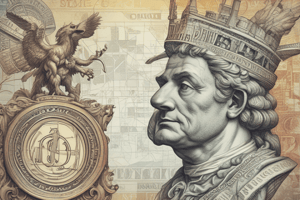Podcast
Questions and Answers
Match the following objectives of public finance with their descriptions:
Match the following objectives of public finance with their descriptions:
Efficient allocation of resources = Maximizing the use of limited resources Income redistribution = Reducing inequality through taxation Economic stabilization = Maintaining steady economic growth Public revenue = Income generated from taxes and fees
Match the types of budgets with their definitions:
Match the types of budgets with their definitions:
Surplus Budget = Revenue > Expenditure Deficit Budget = Revenue < Expenditure Balanced Budget = Revenue = Expenditure Public Expenditure = Government spending on goods and services
Match the types of fiscal policy with their characteristics:
Match the types of fiscal policy with their characteristics:
Expansionary Fiscal Policy = Increases spending or decreases taxes Contractionary Fiscal Policy = Decreases spending or increases taxes Automatic Stabilizers = Policies that mitigate fluctuations automatically Multiplier Effect = Change in spending leads to larger economic output
Match the impacts of public finance and fiscal policy with their outcomes:
Match the impacts of public finance and fiscal policy with their outcomes:
Match the types of taxes with their examples:
Match the types of taxes with their examples:
Match the limitations of fiscal policy with their descriptions:
Match the limitations of fiscal policy with their descriptions:
Match the components of public finance with their definitions:
Match the components of public finance with their definitions:
Match the objectives of fiscal policy with their goals:
Match the objectives of fiscal policy with their goals:
Flashcards are hidden until you start studying
Study Notes
Public Finance
-
Definition: Field of economics dealing with government expenditures, revenues, and the overall fiscal policy.
-
Objectives:
- Efficient allocation of resources.
- Income redistribution.
- Economic stabilization.
-
Key Components:
- Public Expenditure: Government spending on goods and services, infrastructure, and welfare.
- Public Revenue: Income generated from taxes, fees, and other sources.
- Types of taxes: Direct (income tax), Indirect (sales tax, VAT).
-
Budgeting:
- Process of planning government expenditures and sources of revenue.
- Types of Budgets:
- Surplus Budget: Revenue > Expenditure
- Deficit Budget: Revenue < Expenditure
- Balanced Budget: Revenue = Expenditure
Fiscal Policy
-
Definition: Government use of taxation and spending to influence the economy.
-
Objectives:
- Stabilize economic growth.
- Control inflation.
- Reduce unemployment.
-
Types of Fiscal Policy:
- Expansionary Fiscal Policy: Increases government spending and/or decreases taxes to stimulate growth.
- Contractionary Fiscal Policy: Decreases government spending and/or increases taxes to cool down an overheated economy.
-
Mechanisms:
- Multiplier Effect: Change in spending leads to a larger change in economic output.
- Automatic Stabilizers: Economic policies that mitigate fluctuations without direct intervention (e.g., unemployment benefits).
-
Limitations:
- Time lags in policy implementation.
- Political constraints.
- Crowding out effect: Increased public spending might reduce private sector investments.
Impacts of Public Finance and Fiscal Policy
- Economic Growth: Well-planned fiscal policy can enhance overall economic performance.
- Income Distribution: Taxes and social programs play a critical role in reducing inequality.
- Inflation Control: Effective fiscal policies can help stabilize prices during economic fluctuations.
- Debt Management: Responsible management of public finance is crucial to avoid excessive government borrowing.
Public Finance
- Deals with government spending, revenue, and fiscal policy
- Aims for efficient resource allocation, income redistribution, and economic stabilization
- Involves public expenditure on goods, services, infrastructure, and welfare
- Public revenue generated through taxes, fees, and other sources
- Taxes can be direct (income tax) or indirect (sales tax, VAT)
- Budgeting involves planning government spending and revenue
- Surplus budget: Revenue exceeds expenditure
- Deficit budget: Expenditure exceeds revenue
- Balanced budget: Revenue equals expenditure
Fiscal Policy
- Government's use of taxation and spending to influence the economy
- Aims to stabilize economic growth, control inflation, and reduce unemployment
- Expansionary fiscal policy increases spending and/or reduces taxes to stimulate growth
- Contractionary fiscal policy decreases spending and/or increases taxes to cool down an overheated economy
- Multiplier effect: A change in spending leads to a larger change in economic output
- Automatic stabilizers are policies that mitigate economic fluctuations without direct intervention (e.g., unemployment benefits)
- Limitations include time lags in implementation, political constraints, and crowding out effect (increased public spending reducing private investments)
Impacts of Public Finance and Fiscal Policy
- Well-planned fiscal policy can enhance economic performance
- Taxes and social programs play a key role in reducing income inequality
- Effective fiscal policies help stabilize prices during economic fluctuations
- Responsible public finance management is crucial to avoid excessive government borrowing
Studying That Suits You
Use AI to generate personalized quizzes and flashcards to suit your learning preferences.



